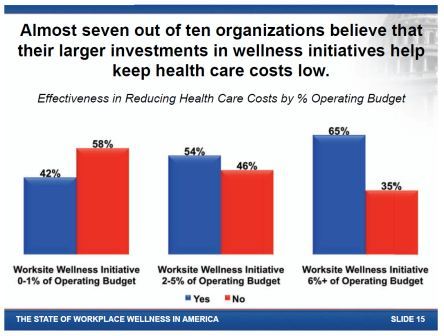
Update
Workplace Wellness Is Catching on, National Public Opinion Poll Shows
-
Focus Areas
Chronic Disease Prevention, Healthy Communities -
Programs
Dialogue4Health

PHI is blogging for National Public Health Week and lifting up programs that exemplify this year’s theme: “Public Health is ROI: Save Lives, Save Money.” For today’s theme, ‘Creating a Healthy Workplace,’ we’re reposting an article from December 17, 2012.
You’re not imagining it. Workplace wellness programs have taken off in offices, plants and other worksites across the nation – and .jpg) are beginning to boost the bottom line, reported speakers at a recent Public Health Institute (PHI) webinar, “Workplace Wellness.”
are beginning to boost the bottom line, reported speakers at a recent Public Health Institute (PHI) webinar, “Workplace Wellness.”
Fifty-five percent of 406 human resources executives surveyed in a new national online public opinion poll presented during the web forum reported that their organization has a workplace wellness initiative in place. Forty-four percent of these initiatives were created five years or longer ago, said Rob Autry, partner at Public Opinion Strategies, who helped design and analyze the survey.
Strong Demand Curve for Workplace Wellness
Workplace wellness is a comprehensive set of strategies to provide support within the work environment, health benefits and workplace policies to help employees improve their health. The programs include subsidized gym memberships, health risk assessments, walking meetings and groups, and providing fresh fruits and vegetables at work.
Webinar speakers indicated that a strong “demand curve” exists for workplace wellness programs to be part of the mix of strategies to address obesity and related health conditions and to help rein in the nation’s sky-high health care costs.
The employee health conditions of highest concern to employers were obesity and overweight, followed by stress and other mental illness, and lack of exercise and fitness.
Employers’ leading reasons for adopting workplace wellness programs were to improve workers’ health, lower health care costs, improve worker productivity and morale, and reduce absenteeism.
“Workplace wellness is an incredibly important part of our effort to improve the nation’s health,” said Jeff Levi, executive director of Trust for America’s Health. “While workplace efforts are a critical venue, I think we all recognize if employees and their families are living in communities that are not supportive of health, that will undermine and diminish the value of workplace wellness.”
You Get What You Pay For
 The employers that saw the most benefit from their workplace wellness initiatives invested two important resources: time and money.
The employers that saw the most benefit from their workplace wellness initiatives invested two important resources: time and money.
The initiatives that were most successful at lowering health care costs were those that committed 2 percent or more of their budgets. And, though a majority of employers’ initiatives found that workplace wellness programs increased productivity, that number grew substantially when employers invested more of their operating budgets. Sixty-five percent of those that have wellness programs said larger investments would have more impact on keeping health care costs low.
Employers want workplace wellness programs to show a benefit right away– eight out of 10 participants wanted measurable return on investment within one to three years. Still, survey results showed that it takes time to build health: by five years, over half of organizations see their health care costs drop, along with employee absences.
Healthy Workplaces Everywhere
85 percent of employers that have the programs were interested in expanding or improving them over the next three years – and 69 percent of employers that don’t offer wellness programs were interested in developing them within three years, Autry said.
What will it take to increase participation?
Employers need to know their investments will pay off down the road. Less than half of employers track return on investment on their current wellness programs, so stronger evaluation efforts could go a long way toward building an evidence base of best practices.
Employers also need a little help. Nine out of ten employers believe that subsidies and financial incentives would increase their interest in these programs.
Some of that support is already in place: special grants from the Affordable Care Act’s Prevention and Public Health Fund gave small businesses $10 million to set up workplace wellness programs. And employers should keep in mind: their workforce will only be as healthy as the community they come from. Bolstering existing resources to build health everywhere—community prevention, public health funding and new resources like the Prevention and Public Health Fund—will pay off for everyone in the long run.
—
The survey results on employer interest, understanding and receptivity to workplace wellness programs were presented in the webinar “Workplace Wellness: A Discussion of New Findings and Efforts to Advance Healthier Communities.” Sponsors of the event, which drew more than 500 attendees, were Prevention Institute, PHI and Trust for America’s Health. The poll findings are contained in the report “The State of Workplace Wellness in America.”
The Society for Human Resource Management conducted the online national opinion poll, which was commissioned by the Alliance for a Healthier Minnesota.
See upcoming web forums from PHI’s Dialogue4Health.
More Updates
Work With Us
You change the world. We do the rest. Explore fiscal sponsorship at PHI.
Support Us
Together, we can accelerate our response to public health’s most critical issues.
Find Employment
Begin your career at the Public Health Institute.



